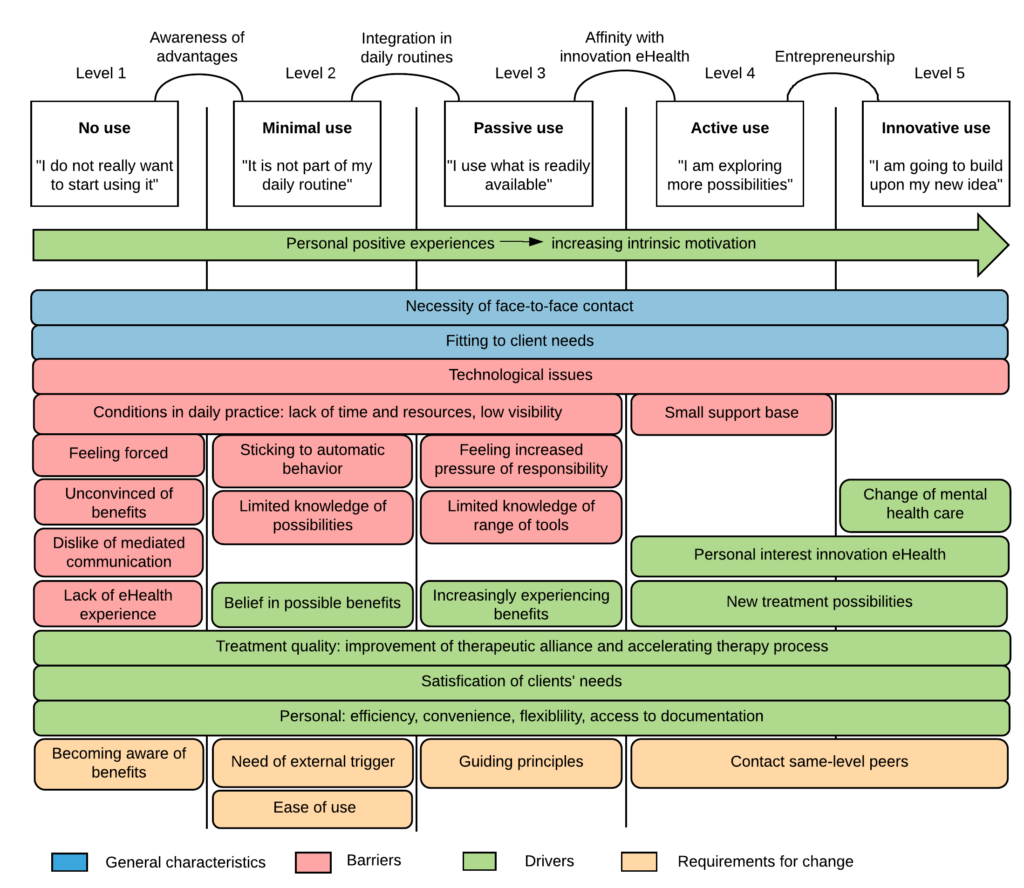Adoption of eHealth
There is growing evidence that eMental Health (EMH) can be comparably effective to face to face treatments, and that it provides several unique benefits. Despite this, studies consistently report that the use of EMH in daily practice is relatively low, finding that 80-90% of practitioners never or only rarely make use of online tools in their routine.
Several studies have aimed to shed light on what determines this low utilization of EMH and have pointed to a variety of factors that can play a role, including characteristics of clients and professionals, technological aspects, and legal and managerial issues.
Further research has shown that practitioners’ adoption plays a crucial role in the implementation process. Therefore, studies have also focused specifically on the perspective of professionals, and found a variety of factors that influence adoption, such as (lack of) perceived benefits, applicability and conditions in daily practice, experience and know-how regarding EMH, and technical issues. Despite these efforts to clarify therapists’ perceptions toward eMental health, the exact nature of therapists’ reluctance to its adoption has remained hard to grasp, and as a result, attempts to increase the uptake and use have not been very successful.
To address this gap, this line of research focuses on clarifying the barriers, drivers, and needs of professionals to adopt EMH.
LAMH Model
To come to a more structured understanding of the adoption process, Feijt et al. have developed the Levels of Adoption of eMental Health (LAMH) model (see figure below), which is a conceptual model that combines knowledge from Roger’s well-established Diffusion of Innovations Theory (Rogers, 1995) with insights from mental health literature and clinical practice.

The model distinguishes five levels of adoption of EMH by mental healthcare professionals, being (1) No Use, (2) Minimal Use, (3) Passive Use, (4) Active Use, and (5) Innovative Use. At each of these levels, the model identifies specific sets of drivers, barriers, and requirements for transition from one level to the next. An important insight captured by the LAMH model is that professionals with different levels of adoption, experience different drivers, barriers and requirements for change, which influence their readiness to adopt EMH. Some of these factors are present across all levels, such as technological challenges and the importance of perceived benefits, but the LAMH model also differentiates between drivers and barriers that are relevant to lower adoption levels and those that are more relevant to higher levels. For example, professionals at level 1 (No Use) are not expected to initiate efforts for further development of EMH tools or promote EMH tools to colleagues, whereas these are typical characteristics of level 4 (Active Use) and 5 (Innovative Use). Furthermore, the model reflects that professionals in lower levels tend to experience a high ratio of barriers to drivers, compared to professionals in higher levels who experience relatively more drivers than barriers.